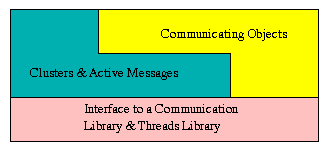![[french]](/sloop/personnel/Nathalie.Furmento/Images/flag_france.gif) Version française
Version française
Schooner's Presentation

[Objectives]
[Programming model]
1. Objectives
Schooner (which means Sloop
Communication Library for High-level,
Object-Oriented, aNd
Efficient Remote Exchanges) is a library
of classes used for writing parallel and distributed applications in
C++. Its main purposes are:
- to be independent of the used communication protocol,
- to give the user a structured and abstract view of its
application (farm of available computers, set of computation
nodes),
- to allow a straightforward redefinition of its
behaviours. Advantages using an object-oriented language
are mainly modularity and reusability: for example, it is
straightforward to add a new message type or to change the
application scalability.
Its low level defines a minimal set of mechanisms that must
be provided for either coarse or fine grained concurrent applications
development (mainly computation entities definition and data exchange
primitives among them). Thanks to inheritance mechanisms, this set can
straightforwardly be redefined and enlarged. Moreover, this set
definition is such that the user can get a structured and abstract
view of its application support (farm of available computers, set of
computation entities supports, ...). Data exchanges between
computation entities is achieved by an active message mechanism - due
to the generality and easy-to-use of this communication model.
This set of mechanisms can be implemented using the
appropriate subset of any C library for communication and
distributed computation supports. Indeed, interfacing any of those
libraries (PVM,
TPVM,
Nexus,
PM2
for example) those mechanisms are either directly available or can be
easily emulated. For instance, a PVM-based Schooner implementation
would - solely - call the pvm_addhost(),
pvm_spawn(), pvm_send(),
pvm_receive() functions.
Schooner is presently used as a run-time support for:
- the C++// system,
- the Prosit environment for
distributed discrete event simulations.
[Back to top]
2. The programming model
The classes that build up the Schooner library can be split into
three layers, depending upon the level of functionality they provide :
- the first layer consists of an interface to any communication
library and, if needed, to any thread library;
- the second layer is built up of classes that allow the
user to create computation nodes also called clusters; these
clusters can interact thanks to active messages;
- a third layer enables to program communicating objects
which also can interact via active messages. If needed, any
communicating object can be bound to a thread and as such be
active.
 The following figure gives a run-time example of an
application built upon Schooner.
The following figure gives a run-time example of an
application built upon Schooner.

2.1 Clusters and computers
Cluster
A cluster can be thought of as an entity which designs a
context (memory, CPU, ...) on a computer. We can also find this
notion in other libraries: environment process of Pt-PVM,
context in Nexus, modules in PM2.
In most cases, a cluster will be mapped on one Unix process,
but we can also choose to group several or all clusters of the
application on a same Unix process. In this way, it is very
straightforward to change the scalability of the application.
Computer
The location for a new Cluster is represented by a
Computer. We can choose to select a specific computer, the ``best
computer'', or a randomized one. The definition of a computer requires
three informations: a symbolic name, the real name of the computer
(network name or IP address) and its architecture.
Many computers with different symbolic names can be associated
to the same physical machine. The use of symbolic name allows to
define a virtual architecture which can be mapped on different
configurations.
Schooner provides one trivial implementation of the ``best
computer'' function. But any Schooner user could derive and rewrite it
using application related informations and also load measures that
could be obtained by external tools (like for example DLB - which is
under development in the SLOOP team - whose aim is to dynamically
provide load informations of a multi-users NOWs).
2.2 Active messages
The model for inter-cluster communications is based on an active
message mechanism. Active messages allows to extend the
message-passing model to a single-sided operation. Once
a message is received on a cluster, a processing function dependent of
the received message type is automatically triggered.
An active message object is an instance of a class which
publicly inherits (directly or indirectly) from the Message
class. This class defines the following member functions:
-
flat(...) which is used to flatten an object
Message in order to send it via the
communication network,
-
rebuild(...) which is used to rebuild an object
Message,
-
process(...) which specifies the processing to
perform when an object of class Message is
received on a cluster.
2.3 Communicating objects
A - possible - third layer of Schooner offers a communicating
objects model. The behaviour of such objects resembles the one of
clusters, in the sense that they interact through active messages sending.
Their main purpose is to enable a finer granularity computation and so, 1 or
many communicating objects can be mapped on a cluster. By a straightforward
derivation and implementation of the communicating object class, Schooner
also provide active communicating objects.
[Back to top]
 Back to Schooner homepage
Back to Schooner homepage
Contact
Last modified: Mon Mar 2 15:26:37 MET

